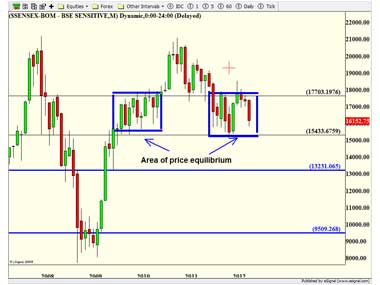By George Albert
The Nifty and the Sensex hit their conservative down targets last Friday to bring about a sharp bear market rally, but the rupee seems headed for further trouble.
In the previous week's article, we had mentioned the next target for the Nifty at 4,800 and for the Sensex at the 16,000 level. The Nifty hit the 4,800 level on Friday on a sharp drop at the open and then rallied strongly.
The Sensex went below the 16,000 level by nearly 200 points to the gap support we had identified last week and then rallied. The complete intra-day swing of the Sensex was nearly 400 points from the low to the high. The low on the Sensex was 15,809 and the high was 16,206. The gaps on the Nifty and Sensex have be working pretty well by slowing the downtrend for two or three days. A look at the charts in last week’s article will show the gaps.
So there are two questions being asked at this point: Does the strong rally on Friday mean that the downtrend is over? The strength of the run-up gives one the impression of this being a bear market rally. In bear markets, short-covering often leads to strong rallies which are later erased. The markets, however, must close below Friday’s low for the selloff to continue.
 The other question being asked is whether the rapid sell off of the past few days is an indication that a market meltdown is on its way. Not yet, as a key milestone has to be cleared. And what is that milestone? It’s an area of price equilibrium on the very long term monthly chart.
An area of price equilibrium is where demand and supply are in balance. When these two opposing forces are in balance, prices stay in a range. The levels of equilibrium are marked by blue boxes on the chart. Notice that between the middle of 2009 and the middle of 2010, prices stayed in a range of 15,000 to 17,700. This is because buyers ard sellers were in balance in that area.
If a seller is met at his asking price by a buyer prices will not fall. And, on the other hand, if a buyer is met by a seller at his bidding price, prices will not rise. It is only when there is no willing seller at a given price that a buyer will raise his price. Similarly, only where there is no buyer at a given price will a seller drop his price.
Now notice that the Sensex has been back to the area of price equilibrium since August 2011. While the heads of short and medium term traders have been spinning with the rise and fall of the Sensex, a step back to the very long term chart only shows a range-bound market. So unless the Sensex closes below the 15,000 level the markets will not have a meltdown. A close below that level will take the Sensex to the 13,250 level after which it can go all the way down to 9,500. But first let the 15,000 level be broken.
The rupee: The Indian rupee closed at a new low against the US dollar on Friday at 54.42 and the previous all-time low was 54.29. In fact, on Friday the rupee went all the way down to 54.89. Like we had said in earlier articles, the markets dance to their own supply and demand melodies. For instance, the Standard and Poor’s downgrade of India did not push the rupee to new lows just as the recent Reserve Bank directive to exporters to get foreign currency into the county did not save the rupee from hitting new lows. The market took its own time in pushing the currency down, which, in large part, was due to an appreciation of the dollar against other currencies.
 However, the dollar index, which measures the US dollar against six major currencies, hit resistance on Friday at the 81.60 level. Prices often fall from resistance and hence we may see the dollar retreat a bit, which could be positive for the rupee. However, notice that the 81.60 levels have been hit a few times, which increases the likelihood that it will be broken and the dollar could rally all the way up to 83.50, pushing the rupee even lower.
em>George Albert is Editor, www.capturetrends.com
(Editor’s note: Due to an error in reading the charts, we had wrongly mentioned 15,500 as the Sensex level that should be breached for another downswing. We have corrected this to 15,000. We regret the error).


)
)
)
)
)
)
)
)
)



